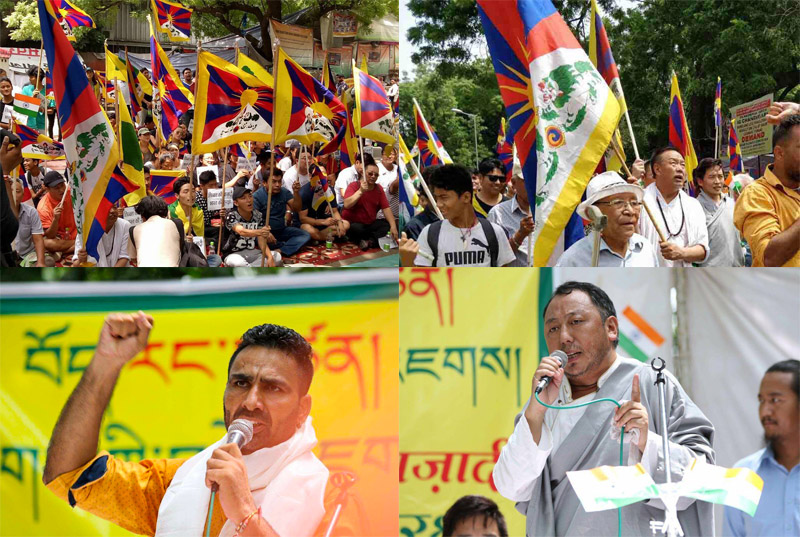 New Delhi — Over 150 Tibetans and Tibet supporters gathered at Jantar Mantar of New Delhi Friday to protest against China's illegal occupation of Tibet and highlight the fact that Tibet's Independence is India's Security.
New Delhi — Over 150 Tibetans and Tibet supporters gathered at Jantar Mantar of New Delhi Friday to protest against China's illegal occupation of Tibet and highlight the fact that Tibet's Independence is India's Security.
Tibetan Youth Congress, the largest Tibetan NGO in exile, organised the protest rally at Jantar Mantar of New Delhi Friday, August 11, 2017, to raise the awareness about China's occupation of Tibet and saying the current standoff between the India and China in the Droklam region reinforces the fact that "India's security lies in an Independent Tibet."
A Chinese diplomat Wang Wenli recently claimed that Bhutan had conveyed to China through diplomatic channels that the area of the standoff is not its territory. In response, Bhutan refuted Chinese government claims about Thimphu telling Beijing that the trilateral border stand-off area in Doklam is not Bhutan's territory.
According to media reports Bhutan had made its position very clear on the issue of Doklam border and urged everyone to refer their statement which has been published on the Bhutan's foreign ministry website on June 29, 2017.
Bhutan has no direct diplomatic relations with China and maintains contacts with Beijing through its diplomatic mission in New Delhi. Bhutan and China have held 24 rounds of talks to resolve boundary dispute, while India and China have completed 19 rounds of talks.
"TYC protest received unprecedented coverage from major international and national media outlets including The New York Times, Washington Post, ABC News, Fox News, Yahoo News and more," TYC President Tenzin Jigme said following their rally, adding: "This is just a small step though."
"Tibet has historically been an independent sovereign nation until the illegal invasion and occupation in 1949. India and China, having never shared a common border in history, was brought face to face for the first time when Mao's marauding forces ravaged the Tibetan plateau and annihilated the buffer that has for centuries fostered peace and amity across the Himalayas," the TYC said in a statement.
The statement continued, "Since then, India and China, two nuclear powers and giants of Asia, have had treacherous eyeball to eyeball confrontations over the decades with the ghosts of the brief yet bloody 1962 war looming large over them. The current standoff between the two countries in the Droklam region which has historically been a part of Tibet, reinforces the fact that India's security lies in an Independent Tibet."
"Historians concur that a part of the Droklam plateau was granted to Bhutan by His Holiness the Great 13th Dalai Lama in 1913. China's expansionist policies and its global ambitions are clearly spelled out in the hostile and callous manner in which they have responded to the ongoing crisis in Droklam. China has played the victim card, led an international diplomatic assault to portray India as the aggressor while sending out not so subtle threats to India," the statement read.
The TYC added that "China has shown no remorse in siding with nations and groups who vehemently oppose India. They have plotted to contain India militarily and limit India's global outreach by blocking India's entry into NSG and obstructing India's candidature as a permanent member of the UN Security Council."
Beyond the strategic vantage point that Tibet holds looking over south Asia, China also controls the mighty rivers that flow down from the plateau which support and sustain livelihoods of hundreds of millions of people living downstream. TYC President Jigme states that, "it is in India's interest that Delhi officially recognizes Tibet as an illegally occupied nation and leads a regional coalition to pressure China on its dismal human rights record and increasingly aggressive geopolitical presages".
"Mao Zedong described Tibet as the palm and Ladakh, Nepal, Sikkim, Bhutan and Arunachal Pradesh as the 'five fingers'. China under the helmsmanship of President Xi Jinping seems eager to wrench the fingers close and form a fist to exert power over the entire region," the TYC's statement further stressed.
From 1958 to 1976, the so called "Great Leap Forward" and "Cultural Revolution" policy of dictator Mao Zedong's communist regime led to the deaths of up to 65-78 million people, including 1.3 million people of Tibet – easily making it the biggest episode of mass murder ever recorded, in the history of the world.
What comes out of this massive and detailed dossier is a tale of horror and genocide in which dictator Mao emerges as one of the greatest mass murderers in history, responsible for the deaths of at least 65 million people during the ten years of Cultural Revolution between 1966 and 1976 that brought chaos and bloodshed in China, Tibet, Mongolia, Manchuria and Eastern Turkistan.
From Mao to Xi Jinping, one after another, the Chinese communist dictators to totalitarians have taken full control over the lives of their own citizens and other nationalists. Today, China is more brutal and inhumane than any other communist regime in the world. The beginning of the 21st century continues to be a time of genocide and violence against the people of Tibet.


![Tibet has a rich history as a sovereign nation until the 1950s when it was invaded by China. [Photo: File]](/images/stories/Pics-2024/March/Tibet-Nation-1940s.jpg#joomlaImage://local-images/stories/Pics-2024/March/Tibet-Nation-1940s.jpg?width=1489&height=878)















